
应用化学 ›› 2022, Vol. 39 ›› Issue (1): 154-176.DOI: 10.19894/j.issn.1000-0518.210491
高效集水仿生超浸润材料的研究进展
- 1.湖北大学功能材料绿色制备与应用教育部重点实验室,湖北大学材料科学与工程学院,武汉 430000
2.中国科学院兰州化学物理研究所,固体润滑国家重点实验室,兰州 730000
-
收稿日期:2021-10-03接受日期:2021-11-05出版日期:2022-01-01发布日期:2022-01-10 -
通讯作者:郭志光 -
基金资助:国家自然科学基金(51735013)
Recent Developments of Biomimetic Superwetting Materials for High Efficiency Water Collection
ZHOU Hui1,2,GUO Zhi-Guang1,2( )
)
- 1.Ministry of Education Key Laboratory for the Green Preparation and Application of Functional Materials,Hubei University,Wuhan 430000,China
2.State Key Laboratory of Solid Lubrication,Lanzhou Institute of Chemical Physics,Chinese Academy of Sciences,Lanzhou 730000,China
-
Received:2021-10-03Accepted:2021-11-05Published:2022-01-01Online:2022-01-10 -
Contact:Zhi-Guang GUO -
About author:zguo@hubu.edu.cn
-
Supported by:the National Natural Science Foundation of China(51735013)
摘要:
有效地收集空气中的雾气是缓解缺水危机的一种方法。近年来,可雾水收集的仿生超浸润材料受到了广泛的关注。通过进一步研究雾水收集过程中的液滴动态运输行为,为设计并构筑多功能仿生超浸润材料提供指导。本综述详细地总结了自然界典型的雾水收集现象,并对液滴在不同润湿性材料表面的动态运输行为进行了分类。从单一仿生到多重仿生出发,系统介绍了近年来仿生超浸润材料在雾水收集应用中的研究进展及雾水收集效果。最后,针对可高效雾水收集的仿生超浸润材料的研究发展进行了展望。
中图分类号:
引用本文
周慧, 郭志光. 高效集水仿生超浸润材料的研究进展[J]. 应用化学, 2022, 39(1): 154-176.
ZHOU Hui, GUO Zhi-Guang. Recent Developments of Biomimetic Superwetting Materials for High Efficiency Water Collection[J]. Chinese Journal of Applied Chemistry, 2022, 39(1): 154-176.
使用本文

图1 (a)仙人掌光学图[21];(b)单根仙人掌刺电镜图[21];(c)仙人掌刺表面的雾水收集机制[21];(d - f)纳米比亚沙漠甲虫及其鞘翅表面图[19];(g)不同体积的甲虫图[35]
Fig.1 (a) Optical images of the cactus[21];(b) SEM image of a single spine[21];(c) Mechanism of the fog harvesting on a spine[21];(d - f) Optical images of the desert beetle Stenocara sp[19];(g) Four model beetles with different size[35]
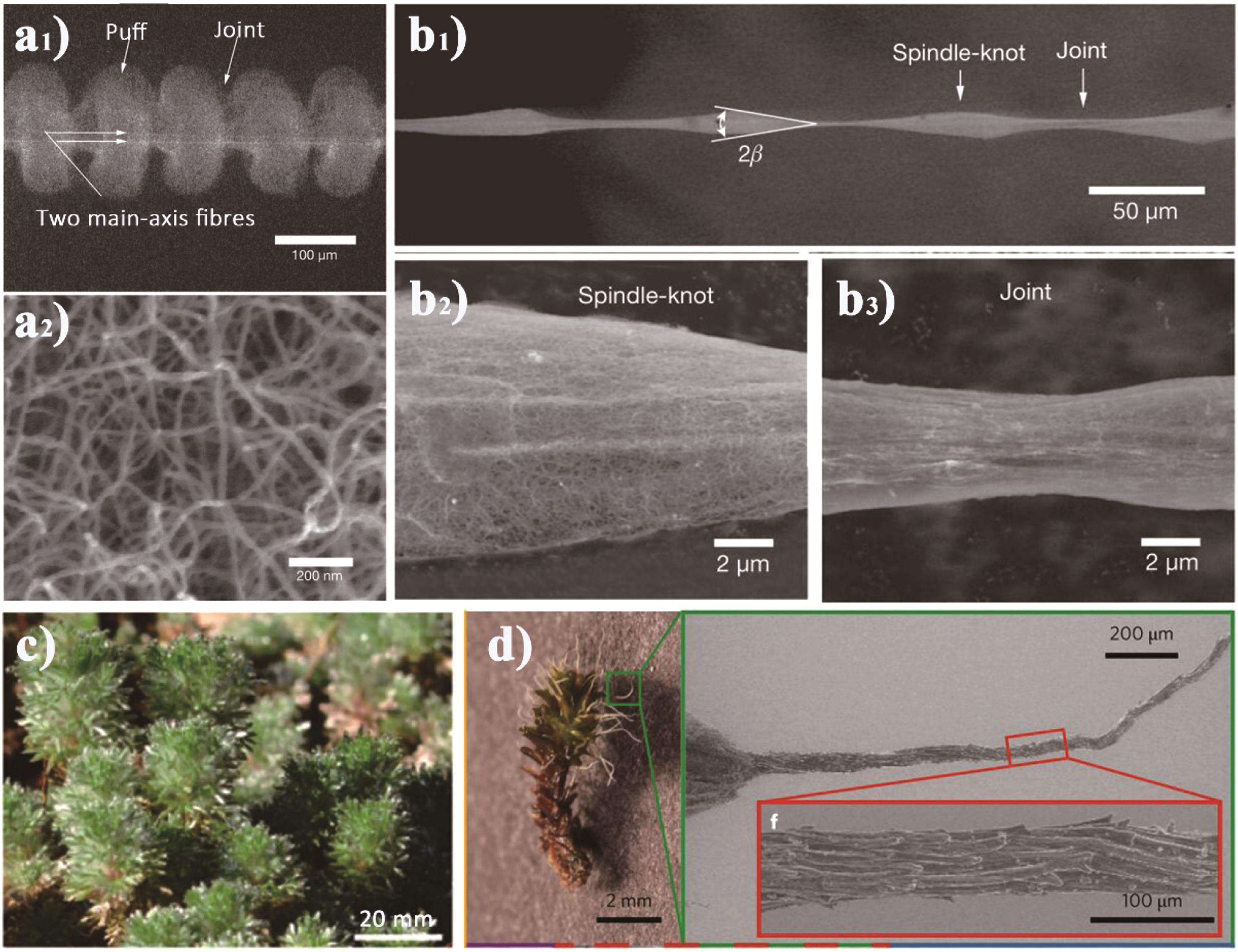
图2 (a)干蜘蛛丝结构图[20];(b)湿润后蛛丝结构图[20];(c)Cotula fallax雾水收集图[44];(d)Syntrichia caninervis光学图及其芒的电子显微镜图[45]
Fig.2 (a) Structure of dry silk of spider[20]; (b) Structure of wet-rebuilt spider silk[20]; (c) Water collected by Cotula fallax[44]; (d)Morphology of Syntrichia caninervis and the associated awns[45]
序号 No. | 生物 Creature | 结构特征 Structural feature | 液滴运输原因 The reason of droplet transport | 文献 Ref. |
|---|---|---|---|---|
| 1 | 仙人掌 Cactus | 锥状刺+毛状体 Spines and trichomes | 粗糙度梯度+结构梯度Gradient of roughness and conical shape | |
| 2 | 沙漠甲虫 Desert beetle | 亲水凸起+疏水四周 Hydrophilic bugle and hydrophobic surroundings | 润湿性梯度 Gradient of wettability | |
| 3 | 蜘蛛丝 Spider silk | 纺锤-链接结构(湿环境) Periodic puffs and joints | 结构梯度 Gradient of morphology | |
| 4 | Cotula fallax叶 Cotula fallax leaf | 3D层次结构:叶子+绒毛Three?dimensional hierarchical structures: leaf and fluff | 多尺度梯度 Multiscale gradient | |
| 5 | 斗篷草 Lady's mantle | 超疏水叶片+亲水中心区 Hydrophilic areas on superhydrophobic surfaces | 润湿性梯度 Gradient of wettability | |
| 6 | 羽扇豆 Lupin | |||
| 7 | 大戟 Euphorbia |
表1 自然界的雾水收集现象
Table 1 The water collection in nature
序号 No. | 生物 Creature | 结构特征 Structural feature | 液滴运输原因 The reason of droplet transport | 文献 Ref. |
|---|---|---|---|---|
| 1 | 仙人掌 Cactus | 锥状刺+毛状体 Spines and trichomes | 粗糙度梯度+结构梯度Gradient of roughness and conical shape | |
| 2 | 沙漠甲虫 Desert beetle | 亲水凸起+疏水四周 Hydrophilic bugle and hydrophobic surroundings | 润湿性梯度 Gradient of wettability | |
| 3 | 蜘蛛丝 Spider silk | 纺锤-链接结构(湿环境) Periodic puffs and joints | 结构梯度 Gradient of morphology | |
| 4 | Cotula fallax叶 Cotula fallax leaf | 3D层次结构:叶子+绒毛Three?dimensional hierarchical structures: leaf and fluff | 多尺度梯度 Multiscale gradient | |
| 5 | 斗篷草 Lady's mantle | 超疏水叶片+亲水中心区 Hydrophilic areas on superhydrophobic surfaces | 润湿性梯度 Gradient of wettability | |
| 6 | 羽扇豆 Lupin | |||
| 7 | 大戟 Euphorbia |

图3 (a - c)Young式方程模型、Wenzel模型和Cassie模型;(d, e)液滴在水平表面及倾斜表面的运动趋势;(f)液滴在具有润湿梯度的表面上的运动趋势[59];(g, h)不同润湿性锥形表面的液滴移动机理[60];(i)液滴在具有粗糙度梯度的表面上的运动趋势[21]
Fig.3 (a - c) Young model, Wenzel model and Cassie model;(d, e) The movement trend of droplet on horizontal surface and inclined surface;(f) The movement trend of droplet on surface with wettability gradient[59];(g, h) Mechanism of water drop motion on conical surface with different wettability[60];(i) The movement trend of droplet on conical surface with roughness gradient[21]
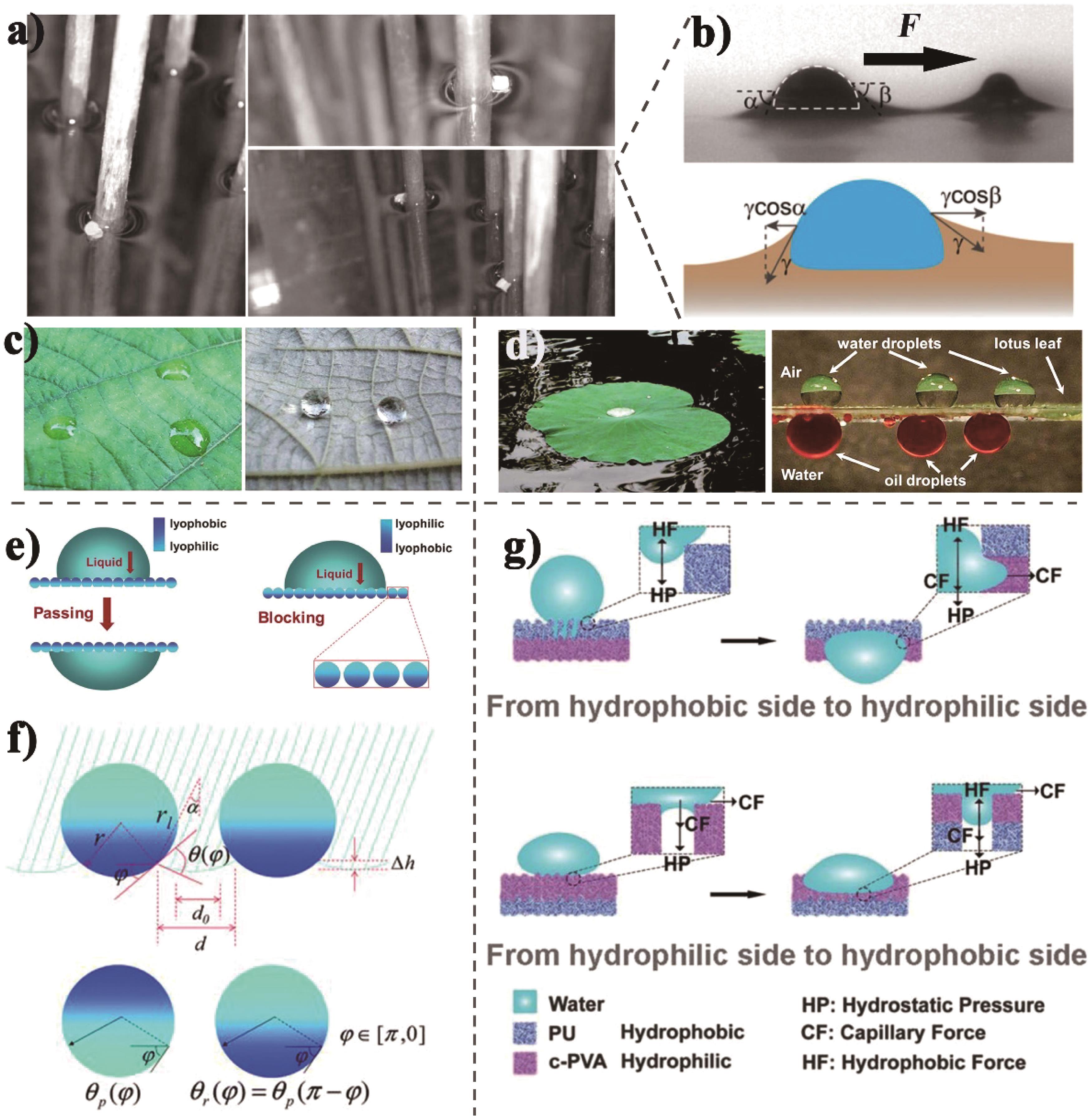
图4 (a)粒子困在圆柱体周围[77];(b)油弯月板引诱的液滴移动[78];(c)苎麻叶图片[81];(d)荷叶图片[83];(e, f)液滴沿横截面方向渗透具有润湿性梯度的微柱膜[85];(g)液滴在Janus膜上单向渗透的机理[86]
Fig.4 (a) Photos of particles trapped against the cylinders[77];(b) Directionally pumping droplets by capillary force on slippery surface with oil meniscus[78];(c) The photos of the ramee[81];(d) The photos of lotus leaves[83];(e, f) The droplet penetration through a microcylinder membrane with a wettability gradient[85];(g) Mechanism of unidirectional water penetration on a Janus film [86]
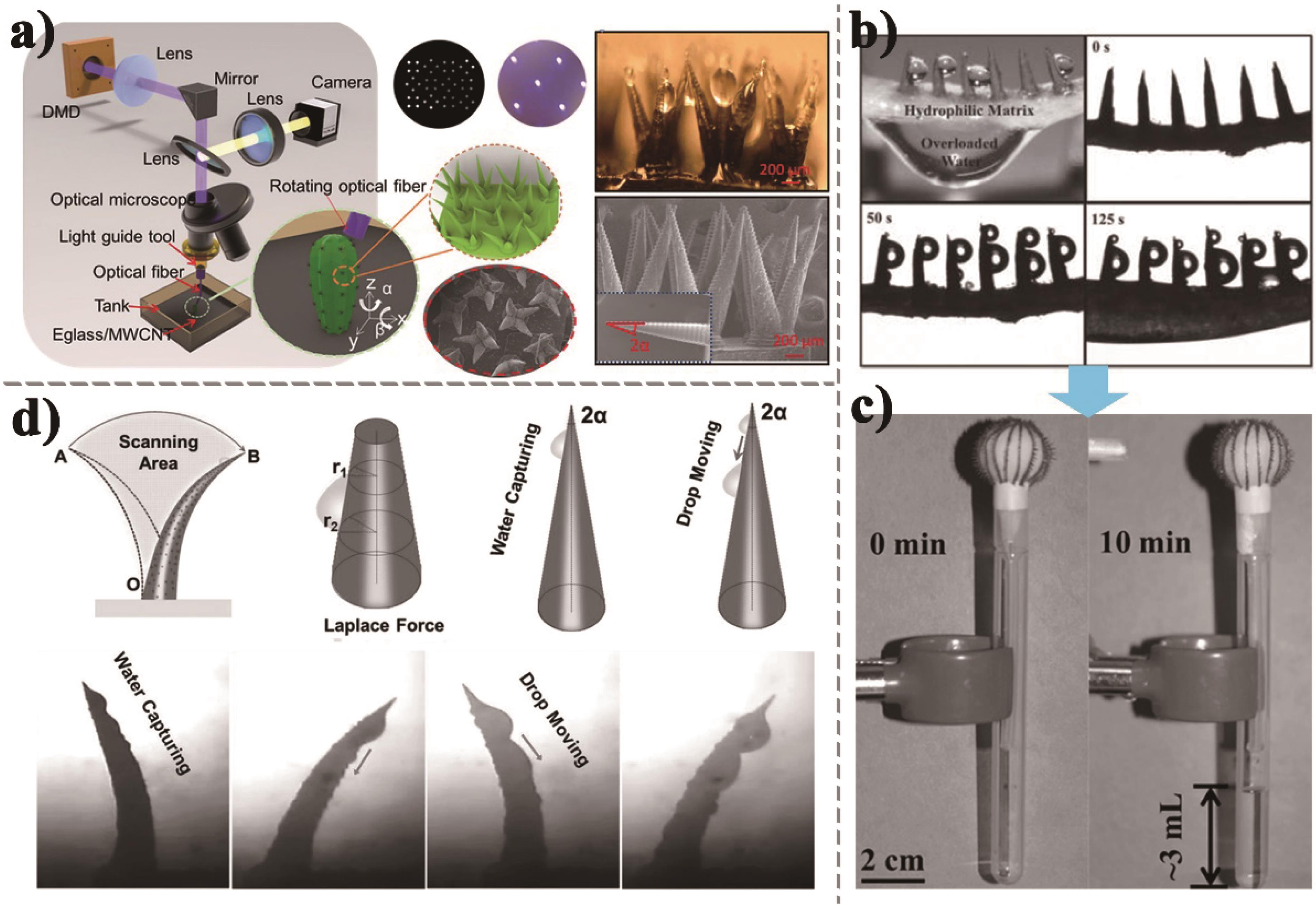
图5 (a)3D打印法制备仙人掌刺阵列[95];(b, c)仿仙人掌集水装置的雾水收集过程[96];(d)液滴在振动作用和拉普拉斯梯度下定向运输[97]
Fig.5 (a) Schematic diagram of 3D-printed cactus-mimetic spine arrays[95];(b, c) The fog collection process of the cactus-inspired device[96];(d) The directional water droplet transport under the cone utilizing vibration and the Laplace force gradient [97]
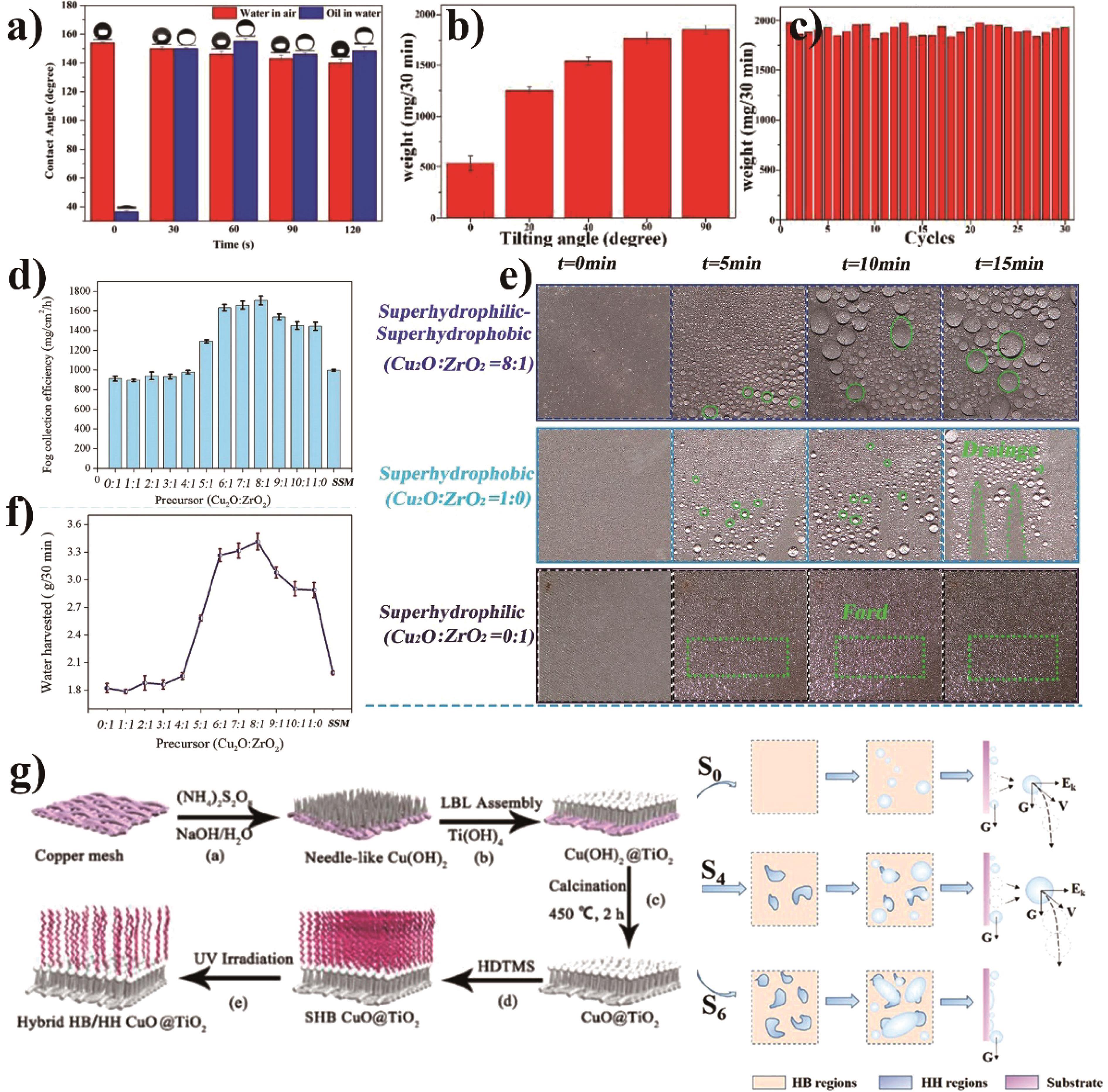
图6 (a)材料表面的接触角及水下油接触角图[98];(b)不同倾斜角度下的集水量[98];(c)不同循环次数下的集水量[98];(d, f)不同前驱物比例样品集水量[99];(e)雾水收集过程[99];(g) 不同样品上水滴的自诱导去除机理示意图[103]
Fig.6 (a) The water contact angle and oil contact angle in water[98];(b) The weight of water harvested at different inclined angles[98];(c) The weight of water harvested under 30 cycles[98];(d. f) Amount of water harvested by various superwetting sample surfaces[99];(e) Optical photographs of the fog harvesting progress[99];(g) Schematic illustration of the self-induced removal mechanism of water droplets on different samples[103]

图7 (a, b) 3D纤维网络的集水过程及机理[106];(c, d)火龙果及仿火龙果的3D集水装置图[107];(e, f)不同润湿性表面集水过程及集水量[108]
Fig.7 (a, b) Illustration of the water-collecting process and mechanism of bioinspired 3D network[106];(c, d) Optical image of pitaya and the schematic diagram of the 3D fog collector[107];(e, f) Images of the harvesting progress and the water weight of different samples[108]
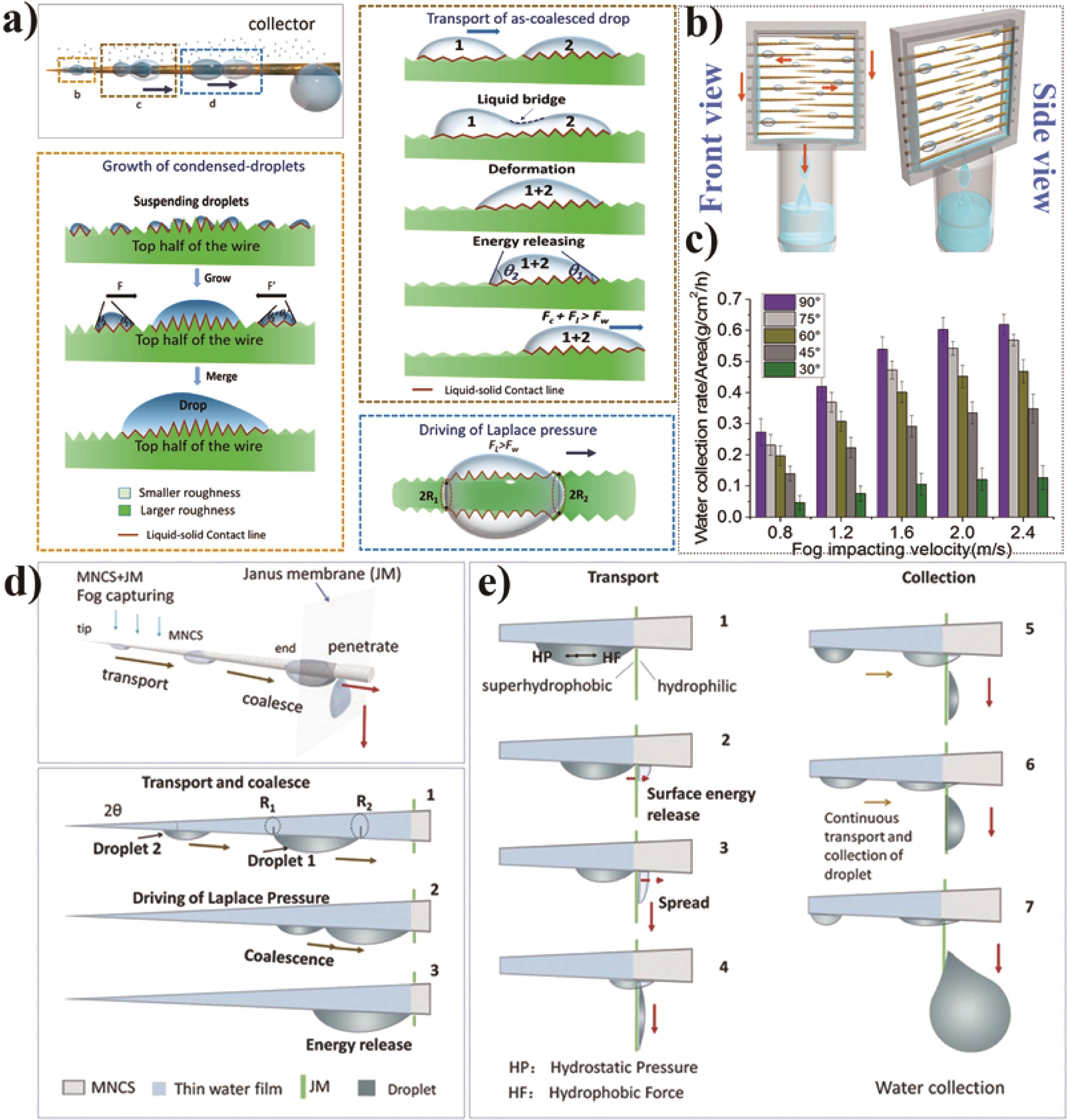
图8 (a)具有周期粗糙度梯度的锥形铜线的集水过程[92];(b)设计的集水装置图及集水效率[92];(d, e)组合集水装置的雾水收集机理[113]
Fig.8 (a) Illustration of fog collection on an artificial periodic roughness-gradient conical copper wire[92];(b) Estimation of water collection rates by water collector[92];(d, e) The mechanism of fog collection by water collector[113]
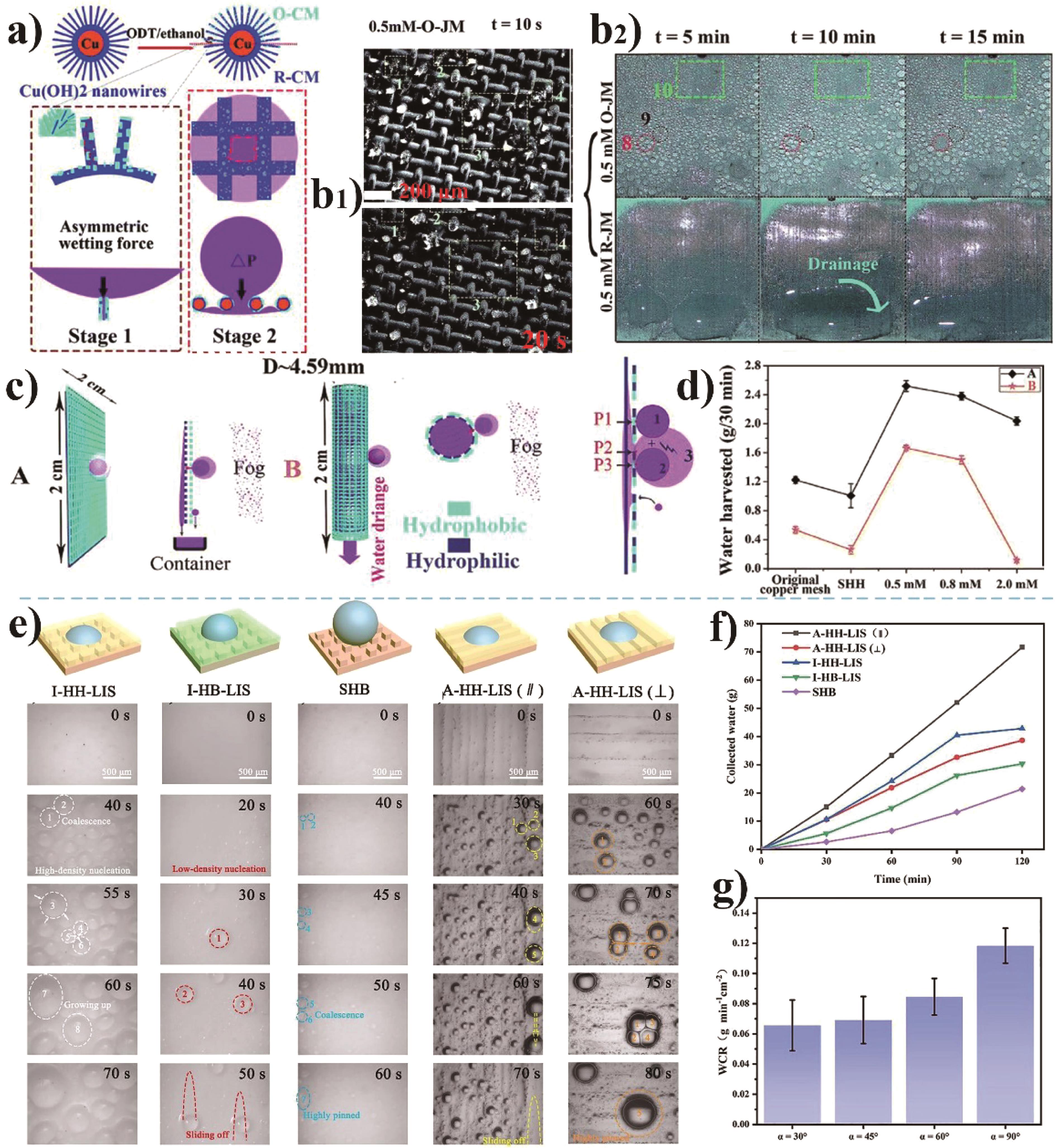
图9 (a) Janus铜网示意图[114];(b) Janus铜网雾水收集过程[114];(c) 3D集水装置[114];(d) 2D和3D集水装置集水量[114];(e-g)不同表面雾水收集过程图及不同表面、不同条件下的集水量[116]
Fig.9 (a) A sketch of the alternating nanoscale (hydrophilic-hydrophobic)/hydrophilic Janus cooperative copper mesh[114];(b) Unidirectional water transport and fog collection on Janus copper mesh[114];(c) A sketch of 3D fog collector[114];(d) The amount of water harvested by 2D flat-like fog harvesting (curve A) and by JM-style fog harvesting (curve B)[114];(e-g) The fog harvesting procedure and the amount of collected water of different samples[116]
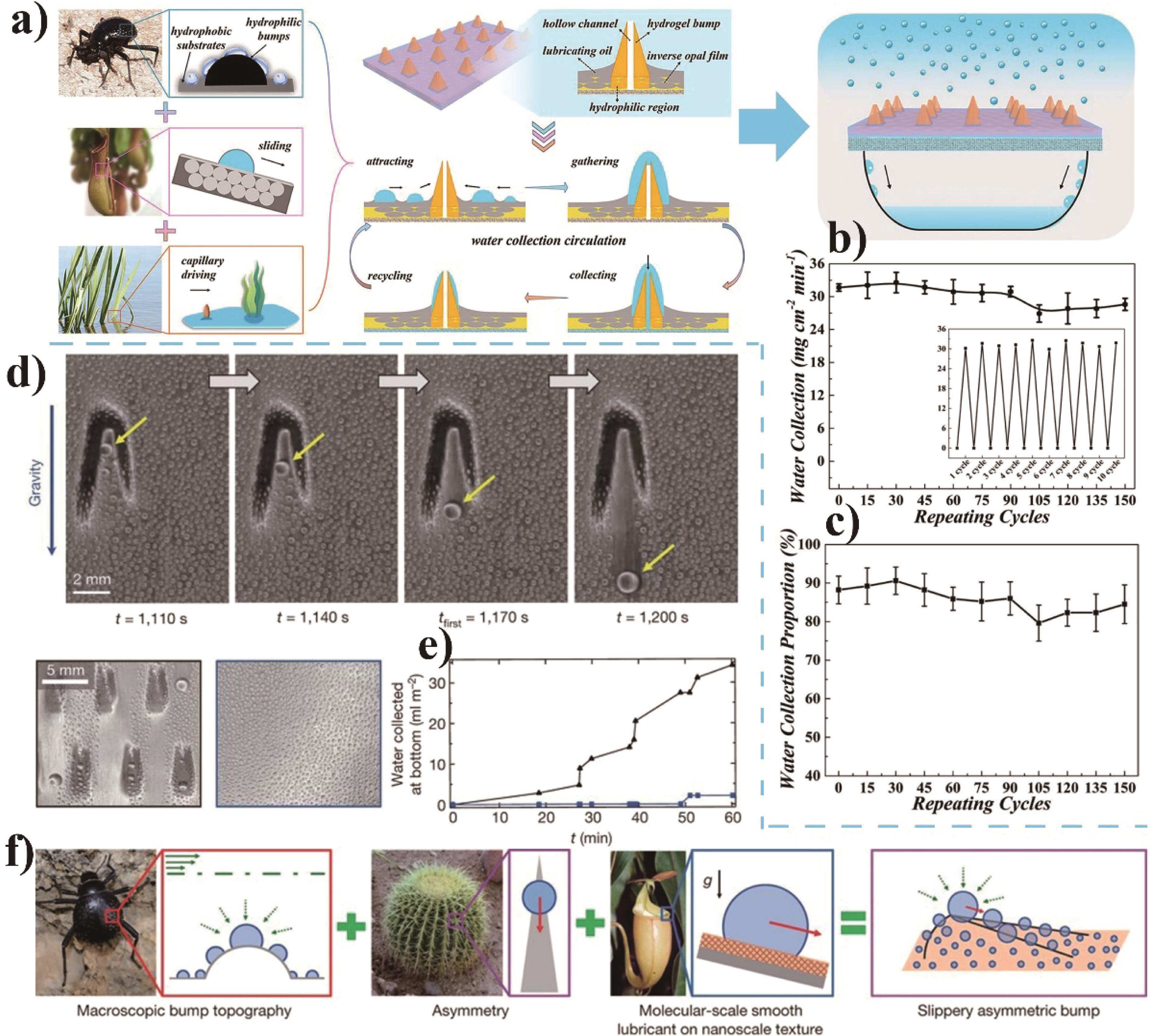
图10 (a)具有中空凸起阵列的多生物仿生滑移表面示意图[117];(b, c)雾水收集中,收集的水量及其总量占比[117];(d - f)多生物特征集水材料设计[118]
Fig.10 (a) Schemes of the multi-bioinspired slippery surfaces with hollow bump arrays[117];(b, c) The amount of collected water and the proportion of water collected relative to the water sprayed on the surface during the water collection cycle[117];(d - f) Design of water collector inspired by multiple creatures[118]
序号 No. | 生物仿生 Biomimetic | 制备方法 Preparation | 集水材料 Fog collector | 雾流速 Flow speed/(cm·s-1) | 雾流量 Flow rate | 温度 Temperature/℃ | 湿度 Humidity/% | 集水量 Water collection rate | 文献 Ref. |
|---|---|---|---|---|---|---|---|---|---|
| 1 | 仙人掌 Cactus | 3D打印法 3D printing | 疏水微锥 Hydrophobic multibranched spines | 100 | - | 室温 Room temperature | 95 | 2 mg/(min·mm3) | |
| 2 | 仙人掌 Cactus | 磁性粒子辅助成型法 Magnetic particle?assisted molding method | 疏水微锥阵列 +亲水棉花基底 Hydrophobic conical arrays with the hydrophilic cotton matrix | 45~50 | - | 23 | - | 3 mL/10 min | |
| 3 | 甲壳虫 Desert beetle | 水热法+浸涂法+后修饰法 Hydrothermal, dip?coating and post?modification method | 亲/疏水性相间 不锈钢网 Hydrophilic/hydrophobic hybrid stainless?steel mesh | 50 | 0.07 g/s | - | - | 977 mg/(h·cm2) | |
| 4 | 甲壳虫 Desert beetle | 喷涂法+后修饰法 Spraying method and post?modification | 亲/疏水性相间 不锈钢网 Hydrophilic/hydrophobic hybrid stainless?steel mesh | 50 | 0.07 g/s | 25 | 85~90 | 1 707.25 mg/(h·cm2) | |
| 5 | 甲壳虫 Desert beetle | 层层自组装沉积法 LBL self?assembly deposition method | 亲/疏水性相间铜网 Hydrophilic/hydrophobic hybrid copper mesh | 50 | 0.07 g/s | 22 | 90 | 571 mg/(h·cm2) | |
| 6 | 蜘蛛丝 Spider silk | 微流控法 Microfluidic method | 人造蜘蛛网 Artificial spider silk web | - | 100 g/(s·m2) | 25 | - | 600 g/h | |
| 7 | 蜘蛛丝 Spider silk | 水热法 Hydrothermal method | 亲水性3D纤维网 Hydrophilic 3D fiber web | 75 | - | 0 | - | 36.07 g/h | |
| 8 | 火龙果叶片Plant Pitaya | 化学刻蚀+后修饰法 Chemical etching and post?modification | 3D集水组合 3D water collector | 60 | 0.037 g/s | 24 | - | 8.64 g/30 min | |
| 9 | 猪笼草 Nepenthes | 水热法+光催化反应 Hydrothermal and photocatalysis reaction | 疏水滑移表面 Hydrophobic slippery surface | 50 | 0.07 g/s | 18 | 90 | ~1.126 g/30 min | |
| 10 | 猪笼草 Nepenthes | 喷涂法 Spraying method | 疏水滑移表面 Hydrophobic slippery surface | 40~50 | 0.07 g/s | 18±2 | 85 | ~460.5 mg/(h·cm2) | |
| 11 | 甲壳虫+Janus 浸润性 Desert beetle and Janus wettability | 液相修饰法 Liquidus modification | 亲水/疏水性相间+Janus浸润性铜网 (Hydrophilic?hydrophobic)/hydrophilic Janus cooperative copper mesh | 50 | 0.07 g/s | 18 | 90 | 2.2 g/(h·cm2) | |
| 12 | 甲壳虫+Janus浸润性 Desert beetle and Janus wettability | 水热法+光催化法 Hydrothermal and photocatalysis reaction | 亲水/疏水性相间+Janus浸润性泡沫铜 (Hydrophilic?hydrophobic)/hydrophilic Janus cooperative copper foam | 25 | ~0.056 g/s | 25 | 70 | 2.39 g/h | |
| 13 | 仙人掌+甲壳虫+猪笼草 Cactus, desert beetle and Nepentes | 化学刻蚀+电沉积法 Chemical etching and electrochemical?deposition | 亲水/疏水性相间锥形铜针+亲水滑移表面 Conical copper needles with gradient wettability and hydrophilic slippery surface | 25 | ~0.056 g/s | 15 | 70 | 8.83 g/h |
表2 雾水收集材料研究进展
Table 2 The research progress of materials for water collection
序号 No. | 生物仿生 Biomimetic | 制备方法 Preparation | 集水材料 Fog collector | 雾流速 Flow speed/(cm·s-1) | 雾流量 Flow rate | 温度 Temperature/℃ | 湿度 Humidity/% | 集水量 Water collection rate | 文献 Ref. |
|---|---|---|---|---|---|---|---|---|---|
| 1 | 仙人掌 Cactus | 3D打印法 3D printing | 疏水微锥 Hydrophobic multibranched spines | 100 | - | 室温 Room temperature | 95 | 2 mg/(min·mm3) | |
| 2 | 仙人掌 Cactus | 磁性粒子辅助成型法 Magnetic particle?assisted molding method | 疏水微锥阵列 +亲水棉花基底 Hydrophobic conical arrays with the hydrophilic cotton matrix | 45~50 | - | 23 | - | 3 mL/10 min | |
| 3 | 甲壳虫 Desert beetle | 水热法+浸涂法+后修饰法 Hydrothermal, dip?coating and post?modification method | 亲/疏水性相间 不锈钢网 Hydrophilic/hydrophobic hybrid stainless?steel mesh | 50 | 0.07 g/s | - | - | 977 mg/(h·cm2) | |
| 4 | 甲壳虫 Desert beetle | 喷涂法+后修饰法 Spraying method and post?modification | 亲/疏水性相间 不锈钢网 Hydrophilic/hydrophobic hybrid stainless?steel mesh | 50 | 0.07 g/s | 25 | 85~90 | 1 707.25 mg/(h·cm2) | |
| 5 | 甲壳虫 Desert beetle | 层层自组装沉积法 LBL self?assembly deposition method | 亲/疏水性相间铜网 Hydrophilic/hydrophobic hybrid copper mesh | 50 | 0.07 g/s | 22 | 90 | 571 mg/(h·cm2) | |
| 6 | 蜘蛛丝 Spider silk | 微流控法 Microfluidic method | 人造蜘蛛网 Artificial spider silk web | - | 100 g/(s·m2) | 25 | - | 600 g/h | |
| 7 | 蜘蛛丝 Spider silk | 水热法 Hydrothermal method | 亲水性3D纤维网 Hydrophilic 3D fiber web | 75 | - | 0 | - | 36.07 g/h | |
| 8 | 火龙果叶片Plant Pitaya | 化学刻蚀+后修饰法 Chemical etching and post?modification | 3D集水组合 3D water collector | 60 | 0.037 g/s | 24 | - | 8.64 g/30 min | |
| 9 | 猪笼草 Nepenthes | 水热法+光催化反应 Hydrothermal and photocatalysis reaction | 疏水滑移表面 Hydrophobic slippery surface | 50 | 0.07 g/s | 18 | 90 | ~1.126 g/30 min | |
| 10 | 猪笼草 Nepenthes | 喷涂法 Spraying method | 疏水滑移表面 Hydrophobic slippery surface | 40~50 | 0.07 g/s | 18±2 | 85 | ~460.5 mg/(h·cm2) | |
| 11 | 甲壳虫+Janus 浸润性 Desert beetle and Janus wettability | 液相修饰法 Liquidus modification | 亲水/疏水性相间+Janus浸润性铜网 (Hydrophilic?hydrophobic)/hydrophilic Janus cooperative copper mesh | 50 | 0.07 g/s | 18 | 90 | 2.2 g/(h·cm2) | |
| 12 | 甲壳虫+Janus浸润性 Desert beetle and Janus wettability | 水热法+光催化法 Hydrothermal and photocatalysis reaction | 亲水/疏水性相间+Janus浸润性泡沫铜 (Hydrophilic?hydrophobic)/hydrophilic Janus cooperative copper foam | 25 | ~0.056 g/s | 25 | 70 | 2.39 g/h | |
| 13 | 仙人掌+甲壳虫+猪笼草 Cactus, desert beetle and Nepentes | 化学刻蚀+电沉积法 Chemical etching and electrochemical?deposition | 亲水/疏水性相间锥形铜针+亲水滑移表面 Conical copper needles with gradient wettability and hydrophilic slippery surface | 25 | ~0.056 g/s | 15 | 70 | 8.83 g/h |
| 1 | SECKLER D, BARKER R, AMARASINGHE U. Water scarcity in the twenty-first century[J]. Int J Water Resour Dev, 1999, 15(1/2): 29-42. |
| 2 | GILBERTSON L M, ZIMMERMAN J B, PLATA D L, et al. Designing nanomaterials to maximize performance and minimize undesirable implications guided by the principles of green chemistry[J]. Chem Soc Rev, 2015, 44(16): 5758-5777. |
| 3 | CARROLL H A, DAVIS M G, PAPADAKI A. Higher plain water intake is associated with lower type 2 diabetes risk: a cross-sectional study in humans[J]. Nutr Res, 2015, 35(10): 865-872. |
| 4 | GORJIAN S, GHOBADIAN B. Solar desalination: a sustainable solution to water crisis in iran[J]. Renewable Sustainable Energy Rev, 2015, 48: 571-584. |
| 5 | KLOOSTERMAN R A, van der HOEK J P, HERDER P. Resilient drinking water resources[J]. Water Resour Manage, 2021, 35(1): 337-351. |
| 6 | VÖRÖSMARTY C J, GREEN P, SALISBURY J, et al. Global water resources: vulnerability from climate change and population growth[J]. Science, 2000, 289(5477): 284-288. |
| 7 | 周威, 陈立, 杜京城,等.仿生雾水收集材料:从基础研究到性能提升策略[J]. 化工学报,2020, 71(10): 4532-4552. |
| ZHOU W, CHEN L, DU J C, et al. Bio-inspired fog harvesting materials: from fundamental research to promotional strategy[J]. CIESC J, 2020, 71(10): 4532-4552. | |
| 8 | ZHU P, LU C X, ZHANG L, et al. Urban fresh water resources consumption of China[J]. Chin Geogra Sci, 2009, 19(3): 219-224. |
| 9 | GOHARI A, ESLAMIAN S, MIRCHI A, et al. Water transfer as a solution to water shortage: a fix that can backfire[J]. J Hydrol, 2013, 491: 23-39. |
| 10 | LUTCHMIAH K, LAUBER L, ROEST K, et al. Zwitterions as alternative draw solutions in forward osmosis for application in wastewater reclamation[J]. J Membr Sci, 2014, 460: 82-90. |
| 11 | CHATURVEDI N D, BANDYOPADHYAY S. Optimization of multiple freshwater resources in a flexible-schedule batch water network[J]. Ind Eng Chem Res, 2014, 53(14): 5996-6005. |
| 12 | ERCIN A E, HOEKSTRA A Y. Water footprint scenarios for 2050: a global analysis[J]. Environ Int, 2014, 64: 71-82. |
| 13 | RIDOUTT B G, PFISTER S. Reducing humanity's water footprint[J]. Environ Sci Technol, 2010, 44: 6019-6021. |
| 14 | MEKONNEN M M, HOEKSTRA A Y. Four billion people facing severe water scarcity[J]. Sci Adv, 2016, 2(2): e1500323. |
| 15 | SCHYNS J F, HOEKSTRA A Y, BOOIJ M J, et al. Limits to the world's green water resources for food, feed, fiber, timber, and bioenergy[J]. Proc Natl Acad Sci USA, 2019, 116(11): 4893-4898. |
| 16 | WANG L X, KASEKE K F, RAVI S, et al. Convergent vegetation fog and dew water use in the Namib Desert[J]. Ecohydrology, 2019, 12(7): e2130. |
| 17 | MEUNIER D, BEYSENS D. Dew, fog, drizzle and rain water in Baku (Azerbaijan)[J]. Atmos Res, 2016, 178/179: 65-72. |
| 18 | KOOL D, AGRA E, DRABKIN A, et al. The overlooked non-rainfall water input sibling of fog and dew: daily water vapor adsorption on a !Nara hummock in the Namib sand sea[J]. J Hydrol, 2021, 598: 126420. |
| 19 | PARKER A R, LAWRENCE C R J N. Water capture by a desert beetle[J]. Nature, 2001, 414(6859): 33-34. |
| 20 | ZHENG Y M, BAI H, HUANG Z B, et al. Directional water collection on wetted spider silk[J]. Nature, 2010, 463(7281): 640-643. |
| 21 | JU J, BAI H, ZHENG Y M, et al. A multi-structural and multi-functional integrated fog collection system in cactus[J]. Nat Commun, 2012, 3: 1247. |
| 22 | ZHONG L S, ZHU H, WU Y, et al. Understanding how surface chemistry and topography enhance fog harvesting based on the superwetting surface with patterned hemispherical bulges[J]. J Colloid Interface Sci, 2018, 525: 234-242. |
| 23 | CHENG Y Q, WANG M M, SUN J, et al. Rapid and persistent suction condensation on hydrophilic surfaces for high-efficiency water collection[J]. Nano Lett, 2021, 21(17): 7411-7418. |
| 24 | ZHOU H, JING X S, LI S P, et al. Near-bulge oil meniscus-induced migration and condensation of droplets for water collection: energy saving, generalization and recyclability[J]. Chem Eng J, 2021, 417: 129215. |
| 25 | BJELOBRK N, GIRARD H L, BENGALURU SUBRAMANYAM S, et al. Thermocapillary motion on lubricant-impregnated surfaces[J]. Phys Rev Fluids, 2016, 1(6): 063902. |
| 26 | LIU G L, KIM J, LU Y, et al. Optofluidic control using photothermal nanoparticles[J]. Nat Mater, 2006, 5(1): 27-32. |
| 27 | DORVEE J R, DERFUS A M, BHATIA S N, et al. Manipulation of liquid droplets using amphiphilic, magnetic one-dimensional photonic crystal chaperones[J]. Nat Mater, 2004, 3(12): 896-899. |
| 28 | LI N, WU L, YU C L, et al. Ballistic jumping drops on superhydrophobic surfaces via electrostatic manipulation[J]. Adv Mater, 2018, 30(8): 1703838. |
| 29 | DAI H Y, GAO C, SUN J H, et al. Controllable high-speed electrostatic manipulation of water droplets on a superhydrophobic surface[J]. Adv Mater, 2019, 31(43): e1905449. |
| 30 | AN R, HUANG L L, LONG Y, et al. Liquid-solid nanofriction and interfacial wetting[J]. Langmuir, 2016, 32(3): 743-750. |
| 31 | DAS G, LIM K J, TANTENGCO O A G, et al. Cactus: chemical, nutraceutical composition and potential bio-pharmacological properties[J]. Phytother Res, 2021, 35(3): 1248-1283. |
| 32 | DUBEUX J C B, SANTOS M V F D, CUNHA M V D, et al. Cactus (opuntia and nopalea) nutritive value: a review[J]. Anim Feed Sci Technol, 2021, 275: 114890. |
| 33 | MITCHELL D, HENSCHEL J R, HETEM R S, et al. Fog and fauna of the Namib Desert: past and future[J]. Ecosphere, 2020, 11(1): e02996. |
| 34 | GOTTLIEB T R, ECKARDT F D, VENTER Z S, et al. The contribution of fog to water and nutrient supply to Arthraerua leubnitziae in the central Namib Desert, Namibia[J]. J Aric Environ, 2019, 161: 35-46. |
| 35 | NøRGAARD T, DACKE M. Fog-basking behaviour and water collection efficiency in Namib Desert Darkling Beetles[J]. Front Zool, 2010, 7(1): 1-8. |
| 36 | BECKER N, OROUDJEV E, MUTZ S, et al. Molecular nanosprings in spider capture-silk threads[J]. Nat Mater, 2003, 2(4): 278-283. |
| 37 | PETERS H M. The spinning apparatus of Uloboridae in relation to the structure and construction of capture threads (Arachnida, Araneida)[J]. Zoomorphology, 1984, 104(2): 96-104. |
| 38 | EDMONDS D T, VOLLRATH F. The contribution of atmospheric water vapour to the formation and efficiency of a spider's capture web[J]. Proc R Lond B, 1992, 248(1322): 145-148. |
| 39 | VOLLRATH F, FAIRBROTHER W J, WILLIAMS R J, et al. Compounds in the droplets of the orb spider's viscid spiral[J]. Nature, 1990, 345(6275): 526-528. |
| 40 | PORTER D, VOLLRATH F. Nanoscale toughness of spider silk[J]. Nano Today, 2007, 2(3): 6. |
| 41 | EMILE O, LE FLOCH A, VOLLRATH F. Shape memory in spider draglines[J]. Nature, 2006, 440(7084): 621. |
| 42 | LIU Y, SHAO Z Z, VOLLRATH F. Relationships between supercontraction and mechanical properties of spider silk[J]. Nat Mater, 2005, 4(12): 901-905. |
| 43 | VOLLRATH F. Strength and structure of spiders' silks[J]. Rev Mol Biotechnol, 2000, 74(2): 67-83. |
| 44 | ANDREWS H G, ECCLES E A, SCHOFIELD W C E, et al. Three-dimensional hierarchical structures for fog harvesting[J]. Langmuir, 2011, 27(7): 3798-3802. |
| 45 | PAN Z, PITT W G, ZHANG Y M, et al. The upside-down water collection system of Syntrichia caninervis[J]. Nat Plants, 2016, 2: 16076. |
| 46 | SHIRTCLIFFE N J, MCHALE G, NEWTON M I. Learning from superhydrophobic plants: the use of hydrophilic areas on superhydrophobic surfaces for droplet control[J]. Langmuir, 2009, 25(24): 14121-14128. |
| 47 | YOUNG T. III. An essay on the cohesion of fluids[J]. Philos Trans R Soc London, 1805, (95): 65-87. |
| 48 | WENZEL R N . Resistance of solid surfaces to wetting by water[J]. Ind Eng Chem, 1936, 28(8): 988-994. |
| 49 | VOGLER E A. Structure and reactivity of water at biomaterial surfaces[J]. Adv Colloid Interface Sci, 1998, 74(1/2/3): 69-117. |
| 50 | TIAN Y, JIANG L. Wetting: intrinsically robust hydrophobicity[J]. Nat Mater, 2013, 12(4): 291-292. |
| 51 | CASSIE A B D, BAXTER S. Wettability of porous surfaces[J]. Trans Faraday Soc, 1944, 40: 546-551. |
| 52 | LIU X L, CHENG P. Dropwise condensation theory revisited Part II. droplet nucleation density and condensation heat flux[J]. Int J Heat Mass Transfer, 2015, 83: 842-849. |
| 53 | DAI X M, SUN N, NIELSEN S O, et al. Hydrophilic directional slippery rough surfaces for water harvesting[J]. Sci Adv, 2018, 4(3): eaaq0919. |
| 54 | 詹晓力, 金碧玉, 张庆华, 等. 多功能超润湿材料的设计制备与应用[J]. 化学进展, 2018 , 30(1): 87-100. |
| ZHAN X L, JIN B Y, ZHANG Q H, et al. Design and applications of multifunctional super-wetting materials[J]. Prog Chem, 2018, 30(1): 87-100. | |
| 55 | NEUMANN A W, GOOD R. Thermodynamics of contact angles. I. heterogeneous solid surfaces[J]. J Colloid Interface Sci, 1972, 38(2): 341-358. |
| 56 | BARTELL F E, SHEPARD J W. Surface roughness as related to hysteresis of contact angles. II. the systems paraffin-3 molar calcium chloride solution-air and paraffin-glycerol-air[J]. J Phys Chem, 1953, 57(4): 455-458. |
| 57 | FOWKES F M. Attractive forces at interfaces[J]. Ind Eng Chem, 1964, 56(12): 40-52. |
| 58 | TIMMONS C O, ZISMAN W A. The effect of liquid structure on contact angle hysteresis[J]. J Colloid Interface Sci, 1966, 22(2): 165-171. |
| 59 | ZHOU H, JING X S, GUO Z G. Optimal design of a fog collector: unidirectional water transport on a system integrated by conical copper needles with gradient wettability and hydrophilic slippery rough surfaces[J]. Langmuir, 2020, 36(24): 6801-6810. |
| 60 | JU J, XIAO K, YAO X, et al. Bioinspired conical copper wire with gradient wettability for continuous and efficient fog collection[J]. Adv Mater, 2013, 25(41): 5937-5942. |
| 61 | LORENCEAU E, QUÉRÉ D. Drops on a conical wire[J]. J Fluid Mech, 2004, 510: 29-45. |
| 62 | BICO J, QUÉRÉ D. Self-propelling slugs[J]. J Fluid Mech, 2002, 467: 101-127. |
| 63 | CHEN W, GUO Z G. Hierarchical fibers for water collection inspired by spider silk[J]. Nanoscale, 2019, 11(33): 15448-15463. |
| 64 | CHAUDHURY M K, WHITESIDES G M. How to make water run uphill[J]. Science, 1992, 256(5063): 1539-1541. |
| 65 | STYLE R W, CHE Y L, PARK S J, et al. Patterning droplets with durotaxis[J]. Proc Natl Acad Sci USA, 2013, 110(31): 12541-12544. |
| 66 | GURERA D, BHUSHAN B. Optimization of bioinspired conical surfaces for water collection from fog[J]. J Colloid Interface Sci, 2019, 551: 26-38. |
| 67 | CHEN H W, ZHANG P F, ZHANG L W, et al. Continuous directional water transport on the peristome surface of Nepenthes alata[J]. Nature, 2016, 532(7597): 85-89. |
| 68 | MALVADKAR N A, HANCOCK M J, SEKEROGLU K, et al. An engineered anisotropic nanofilm with unidirectional wetting properties[J]. Nat Mater, 2010, 9(12): 1023-1028. |
| 69 | 丁雅玉, 苏亚辉, 陈亮. 纳秒激光加工(超)疏水/(超)亲水铝膜的润湿性和雾水收集实验研究[J]. 激光与光电子学进展, 2020, 57(11): 111412. |
| DING Y Y, SU Y H, CHEN L. Experimental investigating wettability and fog collection characteristics of (super)hydrophobic/(super)hydrophilic aluminum membranes processed by nanosecond laser[J]. Laser Optoelectron Prog, 2020, 57(11): 111412. | |
| 70 | PRAKASH M, QUERE D, BUSH J W M. Surface tension transport of prey by feeding shorebirds: the capillary ratchet[J]. Science, 2008, 320(5878): 931-934. |
| 71 | WANG Q B, YAO X, LIU H, et al. Self-removal of condensed water on the legs of water striders[J]. Proc Natl Acad Sci USA, 2015, 112(30): 9247-9252. |
| 72 | CHO H J, PRESTON D J, ZHU Y Y, et al. Nanoengineered materials for liquid-vapour phase-change heat transfer[J]. Nat Rev Mater, 2016, 2(2): 1-17. |
| 73 | GOU X L, GUO Z G. Facile fabrication of slippery lubricant-infused CuO-coated surfaces with different morphologies for efficient water collection and excellent slippery stability[J]. Langmuir, 2020, 36(30): 8983-8992. |
| 74 | LIU J, GUO H Y, ZHANG B, et al. Guided self-propelled leaping of droplets on a micro-anisotropic superhydrophobic surface[J]. Angew Chem Int Ed Engl, 2016, 55(13): 4265-4269. |
| 75 | BOREYKO J B, CHEN C H. Self-propelled dropwise condensate on superhydrophobic surfaces[J]. Phys Rev Lett, 2009, 103(18): 184501. |
| 76 | PERUZZO P, DEFINA A, NEPF H M, et al. Capillary interception of floating particles by surface-piercing vegetation[J]. Phys Rev Lett, 2013, 111(16): 164501. |
| 77 | PERUZZO P, DEFINA A, NEPF H. Capillary trapping of buoyant particles within regions of emergent vegetation[J]. Water Resour Res, 2012, 48(7): W07512. |
| 78 | JIANG J K, GAO J, ZHANG H D, et al. Directional pumping of water and oil microdroplets on slippery surface[J]. Proc Natl Acad Sci USA, 2019, 116(7): 2482-2487. |
| 79 | CAVALLARO M, BOTTO L, LEWANDOWSKI E P, et al. Curvature-driven capillary migration and assembly of rod-like particles[J]. Proc Natl Acad Sci USA, 2011, 108(52): 20923-20928. |
| 80 | PAUNOV V N, KRALCHEVSKY P A, DENKOV N D, et al. Lateral capillary forces between floating submillimeter particles[J]. J Colloid Interface Sci, 1993, 157(1): 100-112. |
| 81 | GUO Z G, LIU W M. Biomimic from the superhydrophobic plant leaves in nature: binary structure and unitary structure[J]. Plant Sci, 2007, 172(6): 1103-1112. |
| 82 | BARTHLOTT W, NEINHUIS C. Purity of the sacred lotus, or escape from contamination in biological surfaces[J]. Planta, 1997, 202(1): 1-8. |
| 83 | CHENG Q F, LI M Z, ZHENG Y M, et al. Janus interface materials: superhydrophobic air/solid interface and superoleophobic water/solid interface inspired by a lotus leaf[J]. Soft Matter, 2011, 7(13): 5948-5951. |
| 84 | YANG H C, HOU J W, CHEN V, et al. Janus membranes: exploring duality for advanced separation[J]. Angew Chem Int Ed Engl, 2016, 55(43): 13398-13407. |
| 85 | TIAN X L, LI J, WANG X. Anisotropic liquid penetration arising from a cross-sectional wettability gradient[J]. Soft Matter, 2012, 8(9):2633-2637. |
| 86 | WU J, WANG N, WANG L, et al. Unidirectional water-penetration composite fibrous film via electrospinning[J]. Soft Matter, 2012, 8(22): 5996-5999. |
| 87 | DONG Y, LI J, PEDERSEN-BJERGAARD S, et al. Unidirectional solute transfer using a Janus membrane[J]. J Membr Sci, 2020, 596:117723. |
| 88 | CAO M Y, LI K, DONG Z C, et al. Superhydrophobic “pump”: continuous and spontaneous antigravity water delivery[J]. Adv Funct Mater, 2015, 25(26): 4114-4119. |
| 89 | ZHOU H, WANG H X, NIU H T, et al. Superphobicity/philicity Janus fabrics with switchable, spontaneous, directional transport ability to water and oil fluids[J]. Sci Rep, 2013, 3: 2964. |
| 90 | CAO H J, GU W H, FU J Y, et al. Preparation of superhydrophobic/oleophilic copper mesh for oil-water separation[J]. Appl Surf Sci, 2017, 412: 599-605. |
| 91 | 李锐, 王立达, 孙文, 等. 超疏水不锈钢网的制备及其雾水收集性能研究[J]. 现代化工, 2020, 40(11): 92-97. |
| LI R, WANG L D, SUN W, et al. Preparation of superhydrophobic stainless steel mesh and study on its performance of fog water collection[J]. Mod Chem Ind, 2020, 40(11): 92-97. | |
| 92 | XU T, LIN Y C, ZHANG M X, et al. High-efficiency fog collector: water unidirectional transport on heterogeneous rough conical wires[J]. ACS Nano, 2016, 10(12): 10681-10688. |
| 93 | SONG Y Y, LIU Y, JIANG H B, et al. Temperature-tunable wettability on a bioinspired structured graphene surface for fog collection and unidirectional transport[J]. Nanoscale, 2018, 10(8): 3813-3822. |
| 94 | LI D K, FAN Y F, HAN G C, et al. Multibioinspired Janus membranes with superwettable performance for unidirectional transportation and fog collection[J]. Chem Eng J, 2021, 404: 126515. |
| 95 | LI X J, YANG Y, LIU L Y, et al. 3D-printed cactus-inspired spine structures for highly efficient water collection[J]. Adv Mater Interfaces, 2019, 7(3): 1901752. |
| 96 | CAO M Y, JU J, LI K, et al. Facile and large-scale fabrication of a cactus-inspired continuous fog collector[J]. Adv Funct Mater, 2014, 24(21): 3235-3240. |
| 97 | PENG Y, HE Y X, YANG S, et al. Magnetically induced fog harvesting via flexible conical arrays[J]. Adv Funct Mater, 2015, 25(37): 5967-5971. |
| 98 | ZHANG Y, ZHONG L S, GUO Z G. A hybrid stainless-steel mesh with nano-array structure applied for efficient fog harvesting by tuning wetting[J]. Chem Lett, 2020, 49(1): 79-82. |
| 99 | FENG J, ZHONG L S, GUO Z G. Sprayed hieratical biomimetic superhydrophilic-superhydrophobic surface for efficient fog harvestin [J]. Chem Eng J, 2020, 388: 124283. |
| 100 | ZHU H, GUO Z G. Hybrid engineered materials with high water-collecting efficiency inspired by Namib Desert beetles[J]. Chem Commun, 2016, 52(41): 6809-6812. |
| 101 | WANG B, ZHANG Y B, LIANG W X, et al. A simple route to transform normal hydrophilic cloth into a superhydrophobic-superhydrophilic hybrid surface[J]. J Mater Chem A, 2014, 2(21): 7845-7852. |
| 102 | ISHII D, SHIMOMURA M. Invisible gates for moving water droplets: adhesive force gradients on a biomimetic superhydrophobic surface[J]. Chem Mater, 2013, 25(3): 509-513. |
| 103 | GOU X L, GUO Z G. Hybrid hydrophilic-hydrophobic CuO@TiO2-coated copper mesh for efficient water harvesting[J]. Langmuir, 2020, 36(1): 64-73. |
| 104 | LIU Y F, YANG N, LI X, et al. Water harvesting of bioinspired microfibers with rough spindle-knots from microfluidics[J]. Small, 2020, 16(9): 1901819. |
| 105 | TIAN Y, ZHU P A, TANG X, et al. Large-scale water collection of bioinspired cavity-microfibers[J]. Nat Commun, 2017, 8(1):1-9. |
| 106 | LI C, LIU Y F, GAO C L, et al. Fog harvesting of a bioinspired nanocone-decorated 3D fiber network[J]. ACS Appl Mater Interfaces, 2019, 11(4): 4507-4513. |
| 107 | ZHONG L S, ZHANG R C, LI J, et al. Efficient fog harvesting based on 1D copper wire inspired by the plant pitaya[J]. Langmuir, 2018, 34(50): 15259-15267. |
| 108 | JING X S, GUO Z G. Durable lubricant-impregnated surfaces for water collection under extremely severe working conditions[J]. ACS Appl Mater Interfaces, 2019, 11(39): 35949-35958. |
| 109 | FAN H F, GUO Z G. WO3-based slippery coatings with long-term stability for efficient fog harvesting[J]. J Colloid Interface Sci, 2021, 591: 418-428. |
| 110 | BAI H, WANG L, JU J, et al. Efficient water collection on integrative bioinspired surfaces with star-shaped wettability patterns[J]. Adv Mater, 2014, 26(29): 5025-5030. |
| 111 | SEO D, LEE J, LEE C, et al. The effects of surface wettability on the fog and dew moisture harvesting performance on tubular surfaces[J]. Sci Rep, 2016, 6: 24276. |
| 112 | SEO D, LEE C, NAM Y. Influence of geometric patterns of microstructured superhydrophobic surfaces on water-harvesting performance via dewing[J]. Langmuir, 2014, 30(51): 15468-15476. |
| 113 | ZHOU H, ZHANG M X, LI C, et al. Excellent fog-droplets collector via integrative janus membrane and conical spine with micro/nanostructures[J]. Small, 2018, 14(27): 1801335. |
| 114 | ZHONG L S, FENG J, GUO Z G. An alternating nanoscale (hydrophilic⁃hydrophobic)/hydrophilic Janus cooperative copper mesh fabricated by a simple liquidus modification for efficient fog harvesting[J]. J Mater Chem A, 2019, 7(14): 8405-8413. |
| 115 | ZHOU H, JING X S, GUO Z G. Excellent fog droplets collector via an extremely stable hybrid hydrophobic-hydrophilic surface and Janus copper foam integrative system with hierarchical micro/nanostructures[J]. J Colloid Interface Sci, 2020, 561: 730-740. |
| 116 | GOU X L, GUO Z G. Reed leaf-inspired anisotropic slippery lubricant-infused surface for water collection and bubble transportation[J]. Chem Eng J, 2021, 411: 128495. |
| 117 | ZHANG X X, SUN L Y, WANG Y, et al. Multibioinspired slippery surfaces with wettable bump arrays for droplets pumping[J]. Proc Natl Acad Sci USA, 2019, 116(42): 20863-20868. |
| 118 | PARK K C, KIM P, GRINTHAL A, et al. Condensation on slippery asymmetric bumps[J]. Nature, 2016, 531(7592): 78-82. |
| 119 | ZHONG L S, ZHU L M, LI J H, et al. Recent advances of biomimetic fog harvesting: focusing on higher efficiency and large-scale fabrication[J]. Mol Syst Des Eng, 2021. DOI: 10.10391D1ME00019E. |
| [1] | 高春雷, 郑咏梅. 仿生多微纳米梯度界面的液滴动态行为调控[J]. 应用化学, 2022, 39(1): 110-130. |
| [2] | 孙灵钰, 郭佳慧, 汪雨, 许冬雨, 赵远锦. 仿生器官芯片研究进展[J]. 应用化学, 2022, 39(1): 18-34. |
| [3] | 张晋红, 石奎, 徐鹏, 李倩, 薛龙建. 仿生表面液固界面摩擦力的动态调控[J]. 应用化学, 2022, 39(1): 188-195. |
| [4] | 刘志浩, 谭晓晴, 梁永鹏, 夏超, 孟建新, 李风煜. 仿生视觉色度识别的浓度快速测定[J]. 应用化学, 2022, 39(1): 196-204. |
| [5] | 刘旭, 李杨可欣, 杜黎, 于健, 王佳程, 耿阳, 韩广, 孙宽, 李猛. 水凝胶的制备及仿生设计在能源领域应用的研究进展[J]. 应用化学, 2022, 39(1): 35-54. |
| [6] | 李胜男, 付俊. 水凝胶仿生柔性电子学[J]. 应用化学, 2022, 39(1): 55-73. |
| [7] | 李春, 于严淏. 仿生矿化的机理和应用研究进展[J]. 应用化学, 2022, 39(1): 74-85. |
| [8] | 张云雷, 赵蔚祎, 麻拴红, 周峰. 仿生干湿摩擦黏附器件的研究进展[J]. 应用化学, 2022, 39(1): 86-98. |
| [9] | 槐梦娇, 刘陶雪婷, 姜忠义. 水通道蛋白启发下的人工水通道研究进展[J]. 应用化学, 2022, 39(1): 99-109. |
| [10] | 徐可睿, 钟志铭, 徐惠东, 王璇, 赵敏, 吴传德. 复合仿生催化体系的构建与高效有氧氧化芳基烷烃[J]. 应用化学, 2017, 34(9): 1079-1085. |
| [11] | 冯晓东, 林晓濛, 王杨, 白凤英, 邢永恒. 聚吡唑硼酸盐钒氧配合物的合成及对苯酚红催化溴化活性[J]. 应用化学, 2016, 33(11): 1303-1309. |
| [12] | 程时远, 李小青, 杨婷婷. 线性聚胺介导的SiO2 杂化纳米粒子的仿生合成[J]. 应用化学, 2009, 26(6): 633-636. |
| [13] | 陈先勇, 唐琴, 胡卫兵. 均匀大颗粒球形碳酸钙的仿生合成[J]. 应用化学, 2009, 26(5): 562-565. |
| [14] | 贺怀贞, 李剑利, 武祥龙, 王陆瑶, 史真. α-萘基环己基甲基酮仿生合成新方法[J]. 应用化学, 2006, 23(6): 685-687. |
| [15] | 吴刚, 陈龙, 谢安建, 沈玉华, 李士阔, 张庆凤. n,o-羧甲基壳聚糖体系中纳米碳酸钙的仿生合成[J]. 应用化学, 2006, 23(10): 1076-1080. |
| 阅读次数 | ||||||||||||||||||||||||||||||||||||||||||||||||||
|
全文 590
|
|
|||||||||||||||||||||||||||||||||||||||||||||||||
|
摘要 1141
|
|
|||||||||||||||||||||||||||||||||||||||||||||||||